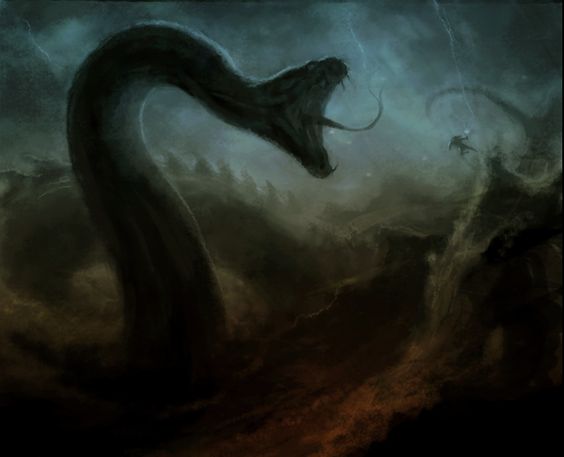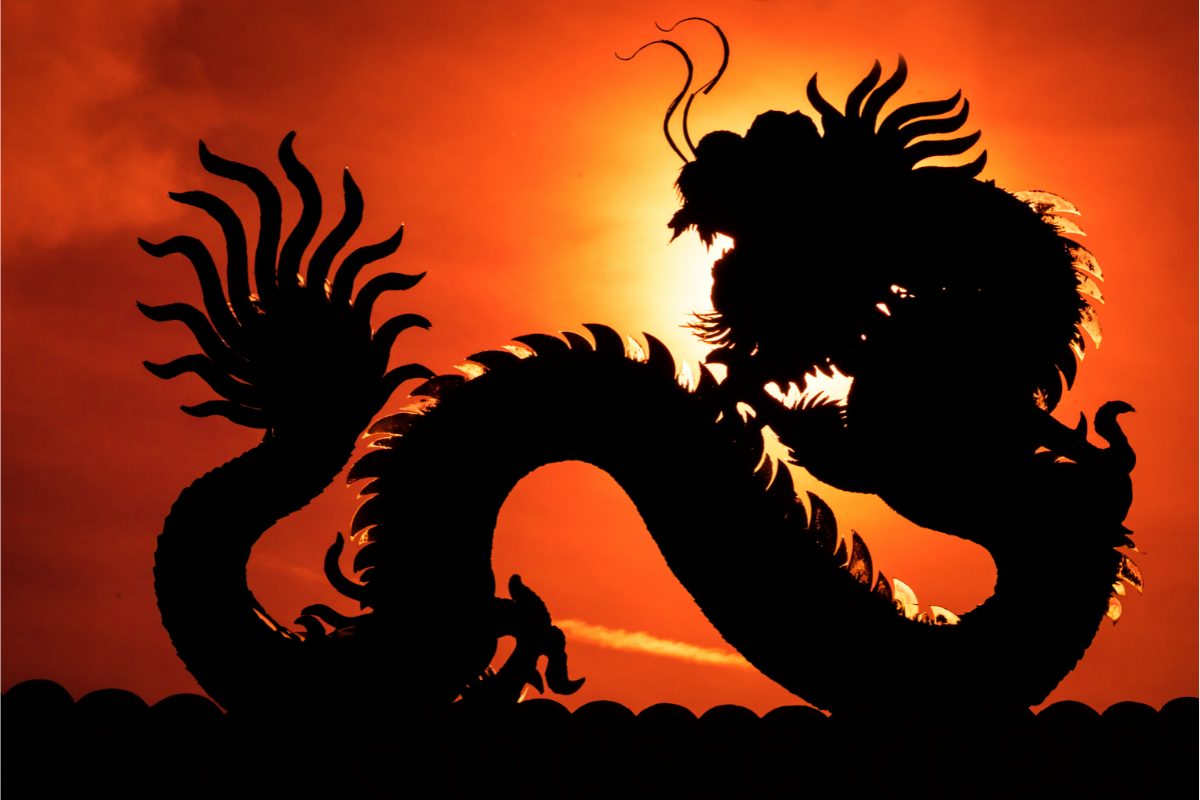Nidhogg is known as Níðhǫggr in Old Norse ("curse-striker" or "he who strikes with malice"). It is a powerful dragon that lives underneath the World Tree Yggdrasil and feeds on its roots.
Nidhogg’s efforts have the purpose of dragging the cosmos back to chaos, and as a result, he and his reptile crew are most certainly able to be categorized as giants.
Is Nidhogg a Serpent or a Dragon?
Nidhogg is an eighty-foot-long dragon that resembles a serpent. It has claws that are both dangerous and sharp. Its scales are shiny black, while the underside of its body is a drab grey color. The tail of Nidhogg is tipped with lethal spikes.
Nidhogg is described as either having no wings or having enormous, membrane-like wings, depending on the source. Nidhogg might be characterized as either a male or a girl, depending on the source.
Nidhogg possesses genius-level intelligence and is aligned ambiguously between good and evil.
Is Nidhogg a Norse God?
No. Nidhogg is only considered to be a dragon creature associated with all evil traits.
Nidhogg Mentions in Norse Mythology
Nidhogg is a common anglicization of the Norse name Nhoggr, which means “Malice Striker.” In Norse mythology, Nhoggr is a Norse dragon that gnaws at the root of Yggdrasil, the world tree. In Old Norse, the name Nhoggr is also usually spelled “Nhggr” [nihz].
In the Gylfaginning section of the Prose Edda, Nidhogg is a being that gnaws on one of Yggdrasil’s three roots. Folklore has it that the roots trap the monster and cannot escape. This root is positioned atop Niflheimr while Nidhogg gnaws at it from below.
Hvergelmir was one of three wells within the roots of the world tree, and Nidhogg made his home there.
From this vantage point, he began to consume the roots to kill the tree and plunge the universe into anarchy. According to some sources, Niflheim, the cold wasteland where Hel and her army of the dead make their home, was near where Nidhogg resided.
The kingdom of Hel is one of many afterlife destinations for humanity. A place called Helheim awaited those who did not die a hero’s death on the battlefield.
Therefore, its name might be a reference to its position as a horrifying monster in the action of devouring the corpses of the people who were guilty of committing crimes such as murder, rape, and breaking oaths.
The Eagle perched above the tree of life and Nidhogg
Throughout Norse mythology, they did not give the eagle that perched above the tree of life a name. Even though they held a mutual hatred for one another, Nidhogg and the eagle never descended from their respective perches to engage in a fight with one another. Instead, they depended on a rodent named Ratatoskr to carry their ill will and insults back and forth between them.
This portion of the story of Nidhogg in Norse myths appears very innocuous and even a little strange when taken at face value. It was nothing of the sort. Mythologies frequently serve as symbols of the cultural ideas they represent. Therefore, the fact that Ratatoskr or Ratatosk was a squirrel was probably due to his position in the mythology.
Because those who delivered angry messages across contending parties were dishonorable, they chose a little creature to represent Ratatoskr. The vengeful quality of the words was another factor that played a role in the poisoning of Yggdrasil.

Nidhogg’s Children
Nidhogg is the parent of many of Niflheim’s dreadful dragons and is considered to be their progenitor.
If Nidhogg were ever to be killed, one of its numerous progeny would eat the root in his place if this happened. Since they have given Nidhogg conflicting descriptions, it is not unimaginable that anything like this has previously occurred at least once.
Redfang, also known as Stjernespise, is an old wingless terrible linnorm. It is Nidhogg’s direct child. We can also find it under the name Stjernespise.
There is a widespread consensus that Nidhogg is the biological parent of all corpse tearer linnorm. They eat rotting flesh and give out an overwhelming smell of death as a byproduct of their behavior. They can blend in with the bark and roots of the trees thanks to their brown, spotty hides.
One of Nidhogg’s children may be the intelligent viper tree, which we can find in Graz’zt’s three tiers of the Abyss. This tree has snakes for branches and could be one of Nidhogg’s kids.
Is Nidhogg Good or Evil?
Nidhogg is evil.
His colossal size and legendary strength have earned him a reputation as a formidable and evil villain.
Why Does Nidhogg Chew On Yggdrasil?
In an eternal effort to weaken and eventually bring down the tree, Nidhogg also gnaws on its roots.
What Does Nidhogg Symbolize?
Nidhogg was a social stigma in ancient Viking culture, signifying dishonor and the label of villain.
Nidhogg and the (Christian) Afterlife
The concept of an afterlife in Norse religion is exceptionally distinct from the beliefs held by people of other cultures and religions.
The afterlife, similar to heaven, is known as Valhalla and Fólkvangr, describing it as being full of fights, feasts, and alcohol. The afterlife, similar to hell, is known as Hel after its overseer and is a cold, mundane, and boring place.
One of the Nidhogg myths, in particular, provides an interesting counterexample to this idea. They depict Nidhogg as ruling over a section of Hel known as The Shore of Corpses in the poem Nástrond. That is the section of Hel that is responsible for meting out punishment to murderers, adulterers, and perjurers.
Although the Nástrond poem is included in the Poetic Edda, Nidhogg’s function in the underworld is typically attributed to the influence of Christianity.
In almost all the other Norse accounts of Helheim, the Norse underworld is not a place of active pain and punishment but a kingdom of endless boredom and uneventfulness.
In other words, they describe the Norse underworld as a place where nothing happens. Nidhogg, the “huge terrible monster,” is most likely connected with a Christianized depiction of the Norse underworld due to the time’s heavy Christian influence.
How Strong Is Nidhogg?
Because of his deadly assault, enormous hit points, and excellent armor, Nidhogg is practically like a one-unit army in and of himself.
He can quickly butcher other units and bring down structures, and because he is a flying unit, he could even fight Titans without fear of being defeated.
Is Nidhogg Immortal?
Yes. Nidhogg is immortal.
Also, he does not experience the effects of aging. An immortal can live for hundreds or millions of years, although they can be killed by poison or in combat.
Is Jörmungandr the same as Nidhogg?
No.
Nidhogg gnaws at the roots of the Yggdrasil tree. He chews on the flesh of those who have committed murder and oath-breaking as he lives in Nastrond, the part of Hel reserved for the most evil of humans. But the Great Tree’s roots prevent him from reaching Midgard and destroying it.

Jörmungandr is a monstrous serpent that grasps its tail in an ouroboros-like fashion and is also called the Midgard Serpent. Jörmungandr surrounds the whole of Midgard.
Additionally, he is Loki and Angrboda’s second child together. It is written in the stars that he will break free at Ragnarök and ultimately be slain by Thor, although Thor will eventually fall victim to his poison and die soon afterward.
Who Is the Strongest Dragon/Serpent in Norse Mythology?
Norse mythology is centered on three dragons, each of which has a distinct personality and serves as a key figure.
- Jörmungandr, also known as the World Serpent, is thought to be the most powerful.
- Fafnir, who engaged in combat with the legendary hero Sigmund, is considered the second greatest.
- Nidhogg would be the third greatest and take great pride in his position as the third greatest.

